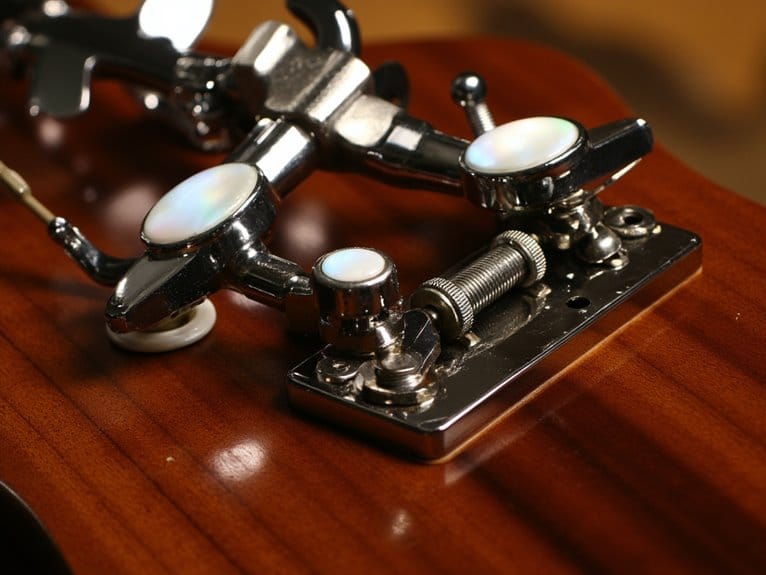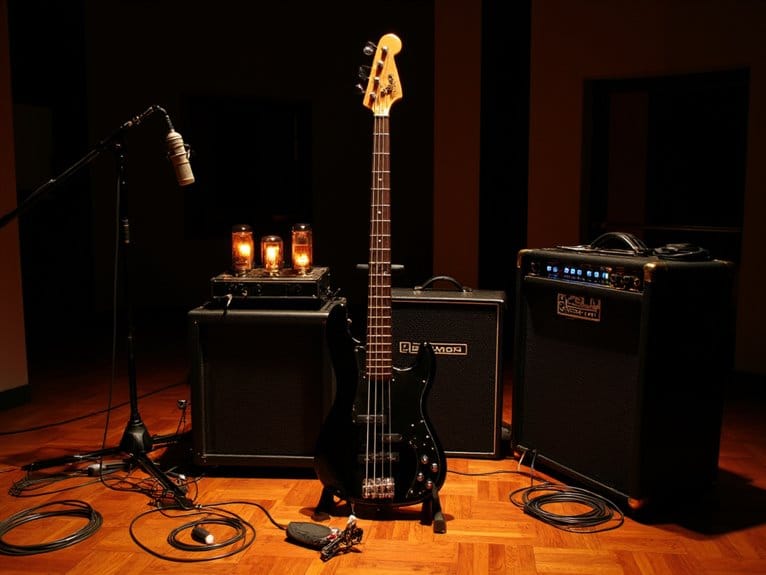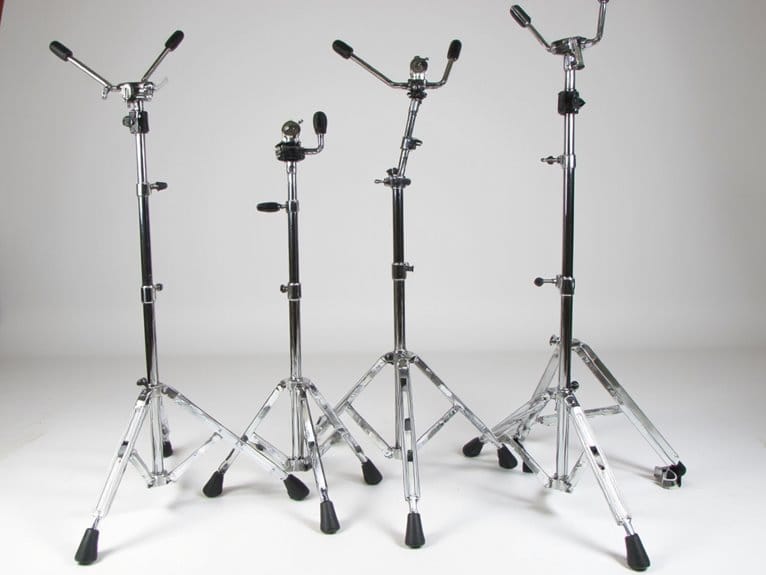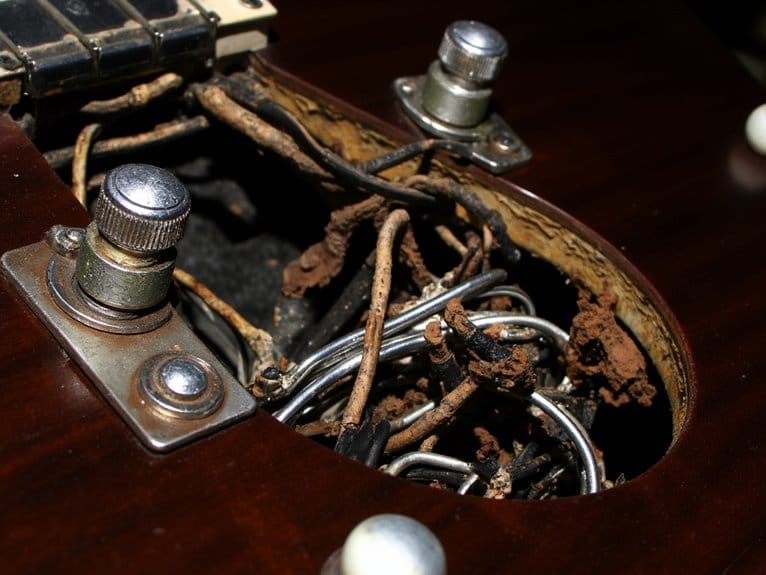Bass Guitar Hardware: Tuners, Bridges, and Their Importance
Your bass guitar’s tuners and bridge form the foundation of playable tone, with tuning pegs engineered for high string tension using specialized gear ratios, while bridge materials like brass, steel, or stainless steel dramatically shape your sound’s brightness and sustain through vibration transfer efficiency. Dense metals improve resonance, string-through-body designs enhance contact area, and proper maintenance with guitar-specific lubricants prevents tuning issues that plague neglected instruments. Understanding how hardware materials interact with your playing style—whether you’re slapping funk lines or holding down jazz walking basslines—unlocks the tonal possibilities waiting beneath your fingertips.
We are supported by our audience. When you purchase through links on our site, we may earn an affiliate commission, at no extra cost for you. Learn more.
Notable Insights
- Tuners handle high bass string tension with specialized gear ratios and robust construction for stable tuning performance.
- Bridge design directly affects sustain and tone through string vibration transfer, with high-mass bridges enhancing resonance.
- Hardware materials like brass, steel, and stainless steel provide distinct tonal signatures through different vibration transfer properties.
- Regular maintenance including cleaning, lubrication, and component inspection prevents tuning issues and ensures long-term reliability.
- Hardware selection should match playing style, with metal requiring stability-focused components and jazz favoring warmer-toned materials.
Understanding Tuner Design and Functionality
When I first started working with bass guitars, I quickly discovered that tuning pegs aren’t just bigger versions of guitar tuners—they’re engineered specifically to handle the substantial tension created by thick bass strings, which can exert forces up to 40% greater than standard guitar strings.
Understanding tuner types becomes essential when upgrading your instrument, as you’ll encounter everything from basic enclosed gear designs to high-precision strobe models favored by professionals.
The robust construction includes durable metal components and specialized gear ratios that maintain stability despite constant string tension. Modern electronic tuners feature needle-style meters that provide quick and accurate pitch indication, making the tuning process more efficient for bass players.
Installation tips I’ve learned include carefully measuring bore sizes and screw hole placement before purchasing replacements, since mismatched specifications can require headstock modifications that affect your bass’s value and structural integrity. Quality aftermarket tuners can significantly improve your bass’s tuning precision and overall sustain performance.
Bridge Types and Their Impact on Sound Quality
After years of swapping bridges on countless basses, I’ve learned that your choice of bridge design affects far more than just aesthetics—it fundamentally shapes how string vibrations transfer through your instrument, influencing everything from sustain characteristics to tonal clarity.
Modern bridge construction varies dramatically, from vintage-style designs with basic adjustment capabilities to high-mass units featuring individual saddle height and length controls that allow precise intonation setting for each string.
Bridge design evolution spans from simple vintage setups to sophisticated high-mass systems offering individual string adjustment and precise intonation control.
String-through-body bridges route strings directly through your bass body, creating enhanced sustain through increased contact area, while swiveling saddle designs enable more accurate fine-tuning by sharing adjustment points between strings.
Despite marketing claims about heavy brass bridges versus lighter alternatives, blind tests often reveal subtle tonal characteristics differences that many players honestly can’t distinguish. Bass guitars experience significant vibrations due to their low frequency output, which can lead to fret buzz and tuning instability if not properly managed by your bridge design.
How Hardware Materials Affect Tone and Performance
Though bridge materials grab most of the attention when discussing tonal influence, I’ve discovered that every piece of hardware on your bass—from tuning machines to strap locks—contributes to your instrument’s overall sonic character through complex interactions between metal density, vibration transfer efficiency, and electromagnetic properties.
Your tuner materials directly impact sustain and resonance through vibration coupling with the headstock, while bridge material choices between brass, steel, and stainless steel create distinct tonal signatures.
Brass delivers warmer, rounded tones, steel provides brightness with pronounced attack, and stainless steel offers corrosion resistance with moderate brightness. Just as hardware materials influence your bass’s inherent tone, the quality of your signal chain components like oxygen-free copper conductors in your cables ensures these tonal characteristics reach your amplifier without degradation.
- Dense metals like steel enhance vibration transfer efficiency, improving sustain and harmonic content
- Non-magnetic hardware materials can alter pickup magnetic fields, affecting clarity and brightness
- Polished finishes create subtle electromagnetic interactions that marginally influence high-frequency response
Understanding how hardware interacts with your strings is equally important, as different string materials like nickel-wound or stainless steel can either complement or counteract your hardware’s tonal characteristics.
Professional bassists often enhance their hardware’s tonal shaping capabilities by incorporating external bass preamp pedals that provide additional EQ control and sound customization options.
Essential Maintenance Practices for Long-Term Reliability
While bass hardware materials shape your instrument’s voice, I’ve learned that consistent maintenance determines whether those sonic qualities remain stable for years or gradually deteriorate into frustrating tuning issues and dead spots.
Your maintenance schedule should include cleaning and lubricating tuners every few months, using guitar-specific lubricants on moving parts to reduce friction and prevent wear.
I always remove strings before deep cleaning, which allows full access to bridges and tuning pegs for thorough dirt removal with microfiber cloths.
Regular inspection of bridge screws, saddle heights, and tuner tightness prevents hardware shifting during play. Many beginner instruments are designed for easy upgrades, but professional setups can transform any bass into a performance-ready instrument that maintains its reliability over time.
Proper string care directly impacts hardware longevity, since old, corroded strings create unnecessary strain on mechanical components, accelerating wear patterns. Choose tuners with sealed mechanisms to protect against dust and moisture for enhanced durability.
Just as bass compressor pedals require true bypass functionality to preserve signal integrity when disengaged, your bass hardware needs clean electrical connections at output jacks and control cavities to maintain optimal signal transfer.
Choosing Hardware for Different Playing Styles and Genres
When I’m helping musicians select hardware for their bass guitars, I’ve noticed that playing style and genre preferences dramatically influence which components will serve them best.
Playing style and genre preferences dramatically influence which bass guitar components will serve musicians best in their specific musical applications.
A metal bassist’s need for maximum sustain and tuning stability under aggressive attack differs completely from a jazz player’s desire for warm resonance and subtle tonal nuance.
Hardware compatibility becomes essential when matching components to your specific requirements, while customization options allow you to fine-tune performance characteristics that align with your genre demands.
- Heavy genres benefit from high-mass bridges and locking tuners that provide exceptional stability during aggressive playing techniques and drop-tuning scenarios.
- Jazz and blues players often prefer brass bridges with vintage-style tuners to achieve warmer tones and smoother mechanical feel during performance.
- Funk and slap bassists need steel bridges with adjustable saddles for bright attack, precise intonation, and quick action modifications.
Most quality bridge upgrades feature drop-in designs that require no permanent modifications to your instrument, making them accessible for both professional setups and DIY installations.
Many bassists also incorporate preamp pedals into their signal chain to further shape their tone and provide additional gain staging between their instrument and amplifier. Similar to how pickup selection varies dramatically between passive and active systems depending on your tonal goals, hardware choices should complement your pickup technology to create a cohesive sound profile that serves your musical style.
Frequently Asked Questions
Can I Install Locking Tuners on Any Bass Guitar Headstock?
You can’t install locking tuners on every bass due to locking tuners compatibility issues. Bass headstock considerations include peg hole diameter, mounting methods, and spacing requirements that may need modifications or professional installation.
Do Heavier Bridges Always Produce Better Sustain Than Lighter Ones?
Heavier bridges don’t always guarantee better sustain than lighter ones. You’ll find that bridge materials, rigidity, and vibration transfer efficiency matter more than weight alone. Various sustain factors including string anchor stability often outweigh simple mass considerations.
Will Upgrading Hardware Void My Bass Guitar’s Manufacturer Warranty?
Upgrading hardware typically voids your manufacturer warranty since most warranties exclude coverage for user modifications. Check your warranty’s modification guidelines first, as warranty implications vary by manufacturer and specific hardware changes you’re considering making.
Are Expensive Tuners and Bridges Worth the Investment for Beginners?
You won’t notice significant performance differences as a beginner, so expensive tuners and bridges aren’t essential initially. Focus your budget considerations on lessons and practice time instead of premium hardware upgrades.
On a final note
You’ve now got the knowledge to make informed decisions about your bass hardware, understanding how tuners, bridges, and materials directly impact your instrument’s performance and tone. Remember, the best hardware isn’t necessarily the most expensive—it’s what matches your playing style, genre preferences, and maintenance capabilities. Don’t overthink it; start with quality basics, upgrade gradually as you develop your sound, and you’ll build a bass that serves you well for years.






